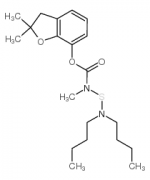
如果遵照规格使用和储存则不会分解,未有已知危险反应
1. 性状:未确定
2. 密度(g/mL,25ºC):未确定
3. 相对蒸汽密度(g/mL,空气=1): 未确定
4. 熔点(ºC):未确定
5. 沸点(ºC):未确定
6. 沸点(ºC,9mm hg):未确定
7. 折射率:未确定
8. 闪点(°C):96
9. 比旋光度(ºC):未确定
10. 自燃点或引燃温度(ºC): 未确定
11. 蒸气压(kPa,25ºC):未确定
12. 饱和蒸气压(kPa,60ºC):未确定
13. 燃烧热(KJ/mol):未确定
14. 临界温度(ºC):未确定
15. 临界压力(KPa):未确定
16. 油水(辛醇/水)分配系数的对数值:未确定
17. 爆炸上限(%,V/V):未确定
18. 爆炸下限(%,V/V):未确定
19. 溶解性:未确定
如果遵照规格使用和储存则不会分解,未有已知危险反应
1. 性状:未确定
2. 密度(g/mL,25ºC):未确定
3. 相对蒸汽密度(g/mL,空气=1): 未确定
4. 熔点(ºC):未确定
5. 沸点(ºC):未确定
6. 沸点(ºC,9mm hg):未确定
7. 折射率:未确定
8. 闪点(°C):96
9. 比旋光度(ºC):未确定
10. 自燃点或引燃温度(ºC): 未确定
11. 蒸气压(kPa,25ºC):未确定
12. 饱和蒸气压(kPa,60ºC):未确定
13. 燃烧热(KJ/mol):未确定
14. 临界温度(ºC):未确定
15. 临界压力(KPa):未确定
16. 油水(辛醇/水)分配系数的对数值:未确定
17. 爆炸上限(%,V/V):未确定
18. 爆炸下限(%,V/V):未确定
19. 溶解性:未确定
1、皮肤/眼睛刺激性:标准德来塞实验:兔子皮肤接触,500 μL/24HREACTION SEVERITY,强烈反应;
对水是稍微有危害的不要让未稀释或大量的产品接触地下水、水道或者污水系统,若无政府许可,勿将材料排入周围环境。
1.疏水参数计算参考值(XlogP):无
2.氢键供体数量:0
3.氢键受体数量:5
4.可旋转化学键数量:10
5.互变异构体数量:无
6.拓扑分子极性表面积67.3
7.重原子数量:26
8.表面电荷:0
9.复杂度:439
10.同位素原子数量:0
11.确定原子立构中心数量:0
12.不确定原子立构中心数量:0
13.确定化学键立构中心数量:0
14.不确定化学键立构中心数量:0
15.共价键单元数量:1